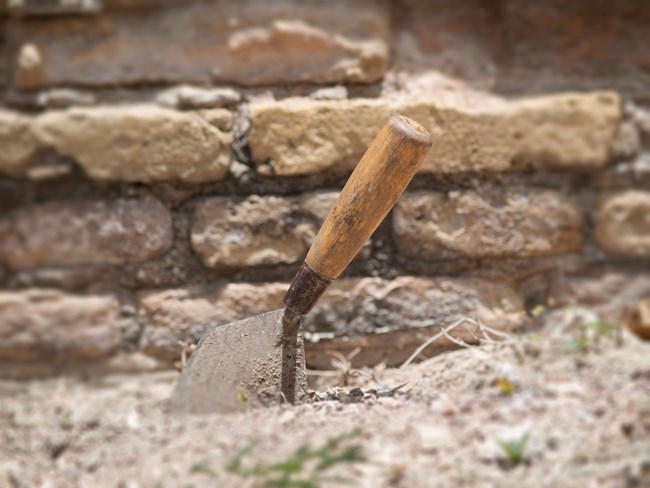
Digging into the Past
Archeologists and historians study and research people from the past – from thousands of years ago to just a few years ago. They study how people lived, what they did, what they ate, how they traveled, and who they met. Historians and archeologists use documents such as maps, diaries, church records, letters, and business records to piece together these untold stories. But many times, no written records exist. Some societies did not have a written language, so there are no records to study. However, all people leave behind ruins of buildings, a pile of trash (midden), and burials in a graveyard.
Archeologists dig in the ground to find evidence of people, whether they lived 100 years ago or 2,000 years ago. Archeologists find the ruins of homes, tools, items used for cooking and eating, and sometimes even the food itself. The items that people leave behind are called artifacts. Archeologists make observations about how people lived based on the artifacts and their context – the ground in which they are buried, the environment, and other factors. An observation is information gathered by using one of the five senses.
However, artifacts, tell only part of the story. Historians and archeologists must use their observations and research to infer the entire story of how people lived in the past. To infer is to reach a conclusion about something based on observations or hypotheses.
Archeologists bring artifacts back to the laboratory, where they are cleaned and analyzed.
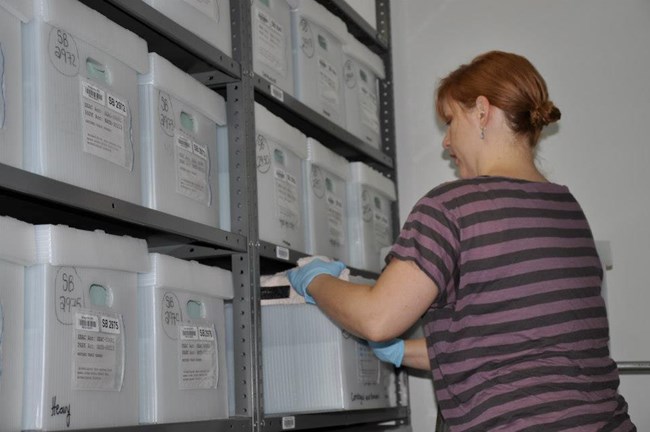
What Happens Next?
An archeologist’s job isn’t finished when she or he has excavated a site and cleaned and analyzed the artifacts. The artifacts have to be cared for a long, long time; they have to be curated. Museum specialists work with archeologists to preserve and keep these objects in safe, secure environments. There are many reasons to do this. For example, a park may want to use them in a museum display, or a student or researcher may need to study an object for a special project.
Some artifacts need special treatment or they will fall apart. Examples include an iron cannon from a shipwreck in the ocean, a carved wooden flute from a wet bog in the Everglades, or parts of a pre-Civil War flintlock musket, removed from the ground. Museum specialists know how to take care of these objects so they can be preserved for the future – they conserve artifacts and objects. Museum specialists also rescue and repair artifacts and objects that have been damaged, such as from a flood or a hurricane.
How can archeologists tell the age of an artifact? They use several techniques. They use chemistry to test for certain elements, such as carbon. Carbon is found in all living things. As soon as something dies, the amount of carbon it contains begins to decay, or go away. Archeologists can measure how much carbon is left in an object that used to be alive. For example, a shell that used to be a home for an animal, a tree, or a person, in order to determine when it died. This technique is called Carbon-14 dating.
Archeologists strive to tell people what they’ve found and why they excavate sites. They also work with volunteers, like Boy Scouts, to help excavate sites.
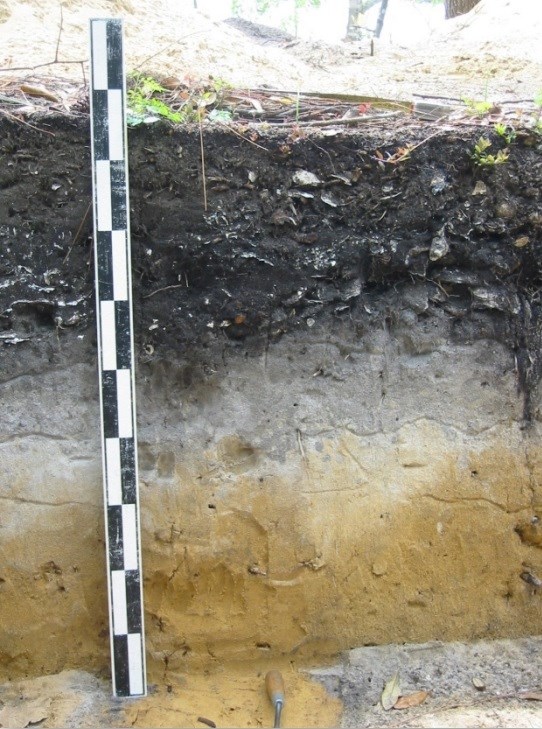
Pieces of the Puzzle
When archeologists excavate or dig into a site, the artifacts normally are found in layers of dirt, called strata. Generally, the layers on the bottom are older than those on top; they were deposited first. This is called the law of superposition. So, artifacts that are in the bottom layers normally are older than those in the upper layers. Sometimes animals or people will dig into the strata, as when a mouse or crab burrows a hole, or a person puts a post in the ground to build a fence. This can move artifacts up and down in the soil and cause confusion. However, a good archeologist will see this and be able to determine what happened. The stratigraphy of an archeological site is the combination of all the different strata.
Tools of the Trade
What tools do archeologists use? Let’s see: they carefully dig in the ground, clean artifacts, record information, read and research in libraries and museums, and carefully store the artifacts in places that are safe from the environment and ensure that they can’t be stolen!
Many Stories in Time
In the United States, archeologists study clues about people who lived more than 12,000 years ago! To better understand ancient societies and how their cultures have changed over time, archeologists have divided prehistory into four main periods.
PaleoIndian, 12,000 – 10,000 B.C. This is when people arrived in the Americas, and the glaciers were melting. Small groups or bands of people followed and hunted large animals such as mammoths and mastodons. People were living in the Southeast, too, even in the Florida peninsula and the Coastal Plain. Sea levels were much lower than they are today, so much so that the beach at the Gulf of Mexico was actually many miles further out. And just like today, people were living there. These ancient beach sites are now under water.
Archaic, 8000 – 1000 B.C. During this period, sea levels were rising and the glaciers were almost completely gone. People were still living in small bands or groups and moving across the landscape within territories. Over time, they developed large camps and traveled between them during the seasons as different foods became available. Later, people began to experiment with different kinds of plants, and they began to make pottery.
Woodland, 1000 B.C. – A.D. 1000. People were now living in tribes and beginning to settle down into villages. Some of these tribes had leaders or rulers, and some were quite powerful. They were planting crops and still hunting and gathering, and making pottery vessels to store and cook foods. Some societies made mounds out of earth or shell, for ceremonies and to bury their dead. Trade and exchange networks were established that moved goods across very long distances.
Mississippian, A.D. 1000 – 1600. Societies were developing social and status classes. Some people were powerful political and religious leaders, while others were chiefs and nobles; others were traders and farmers; and others were slaves. People lived in many types of villages: in single farms, small villages with one mound, and large towns with many mounds. Many of these villages were located near rivers, with soils good for growing lots of food. Powerful people traded with communities that were far away for luxury goods, such as copper from Michigan and conch shells from south Florida. They exchanged goods through networks that linked hundreds of communities together. This timeline shows you what was going on around the world.
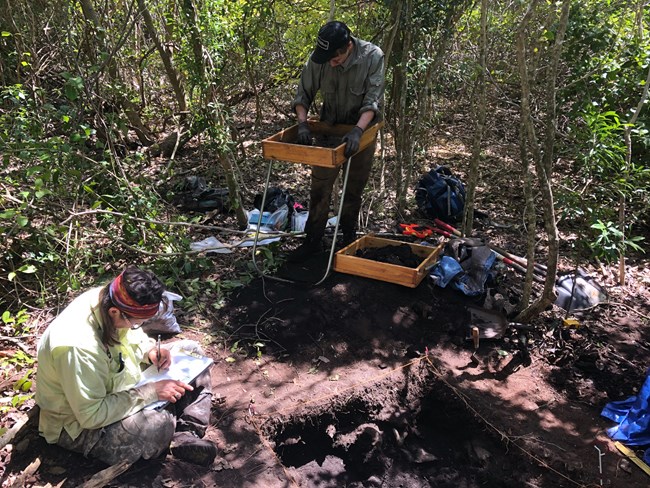
Home Sweet Home
Archeologists find evidence of where and how people lived – how their houses were made, their ceremonial temples, how they cooked food, where they planted gardens and fields to grow food, how they got ready for hunting or gathering expeditions, where they dumped their trash, and how they buried their dead. Archeologists find this evidence in the least likely places, such as swamps, the Everglades, and on barrier islands that are more than 10 miles from the shore!
Some of the oldest archeological sites in the Southeast can be found in caves. People were living in Russell Cave (Russell Cave National Monument) in northern Alabama nearly 10,000 years ago! They lived at the cave’s entrance for protection from the weather and because it was close to many resources including animals to hunt, nuts and berries to eat, and freshwater. There was a fresh water spring near the entrance to the cave, and the stream still flows into the cave today. People lived at Russell Cave off and on for more than 9,000 years and left behind one of the most complete records of prehistoric human life in the Southeast. Many kinds of artifacts have been found there – pottery, animal bones, seeds, and tools and weapons made from stone and bone. Some of these artifacts have been found as deep as 30 feet below the present floor of the cave. And some of the artifacts did not come from Alabama, but from far away, telling us that these ancient people were trading goods with other people.
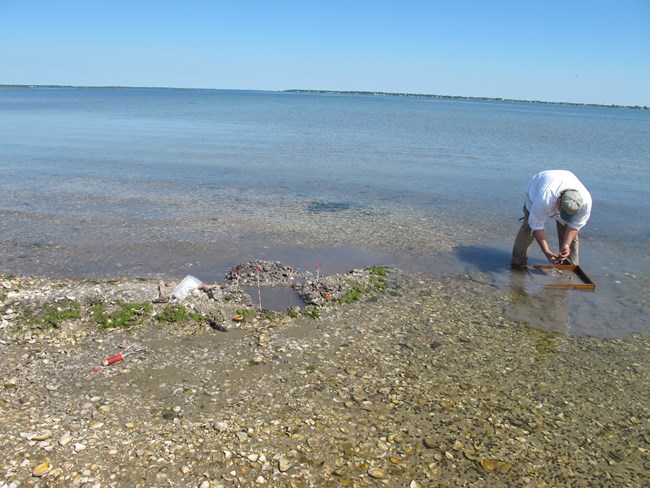
People began to in settle in villages, some small and some very large. At many villages people began to build large ceremonial mounds and platforms out of earth or shell to conduct religious acts or bury their dead. Sometimes their chiefs would live on top of one of the mounds. Archeologists call these societies “chiefdoms.” The village of the residents was located among and around the mounds. Some of the largest villages were more like towns, with hundreds or even thousands of people living there! Homes were made out of wattle-and-daub, mud stuck onto a frame made of wood and twigs, with roofs made of grass, palm leaves, or thatch. Many homes were measured between 8 and 30 feet (2.5 and 9 meters) across.
Parks like Shiloh National Military Park and Ocmulgee National Monument contain remains of earthen temple and burial mounds that are more than 1,500 years old! These large villages needed to feed the people living there. In areas with good soil and water people began to experiment with growing food – the start of what we call horticulture. But they continued to hunt and gather foods, sometimes hiking and camping many miles away from their homes.
In coastal or swampy areas where the soil was not good for growing lots of food, people still built large villages and lived for hundreds of years. This was possible because abundant fish, shellfish, birds, other animals, and plants could be counted on for food all year. These mounds and villages were made of shells. Parks such as Everglades National Park, Big Cypress National Preserve, Jean Lafitte National Historical Park and Preserve, Cape Lookout National Seashore, and Canaveral National Seashore have evidence of villages located on or near the ocean, large bodies of water, or rivers of grass. At Gulf Islands National Seashore, archeologists have found evidence that people paddled canoes 8 or 9 miles across the Mississippi Sound to large islands, where they fished and gathered shellfish. They even camped and buried their dead out on these remote islands.
In other places, people moved back and forth from the coast, or from village to village and camp to camp far from the coast, as certain plants and animals were available to eat during different seasons. People traveled by walking or paddling canoes.
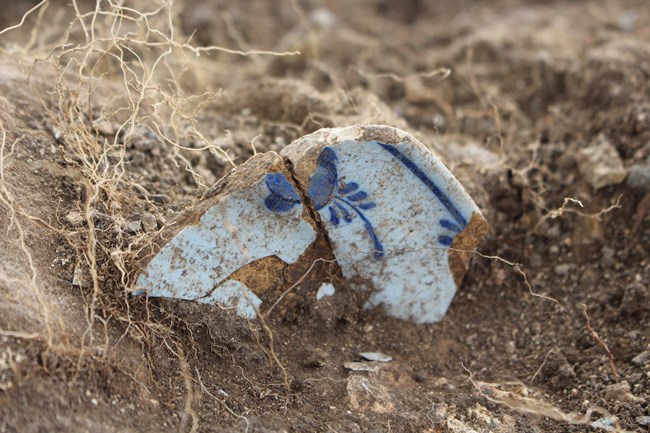
Settling the Frontier
Archeologists also study places that are not quite as old. Historic sites are those with written records, such as rules and laws, newspapers, announcements, business records, church records, and personal messages. In the Southeast, this refers to the time after the arrival of Europeans (after 1492). There are all kinds of historic sites – small farms, large plantations, factories, forts, small towns, and large cities. Archeologists use historic documents and old maps to discover how villages and towns were created, how people got food and other goods, and how they lived.
The oldest city in the United States is St. Augustine, Florida. It was established in 1565, by Spanish explorers who were told to establish a fort on the Atlantic Coast of La Florida (the Spanish name for Florida). St. Augustine was a bustling port city; it was laid out as a grid, with streets running north-south and east-west. And it had a fort; actually, there were 8 forts before the final stone fort, Castillo de San Marcos, was built. And it’s standing today!
Many other old historic cities also were laid out in a grid: New Orleans, Louisiana; Savannah, Georgia; Charleston, South Carolina; Pensacola, Florida; Mobile, Alabama; San Juan, Puerto Rico; and Christiansted, Virgin Islands.
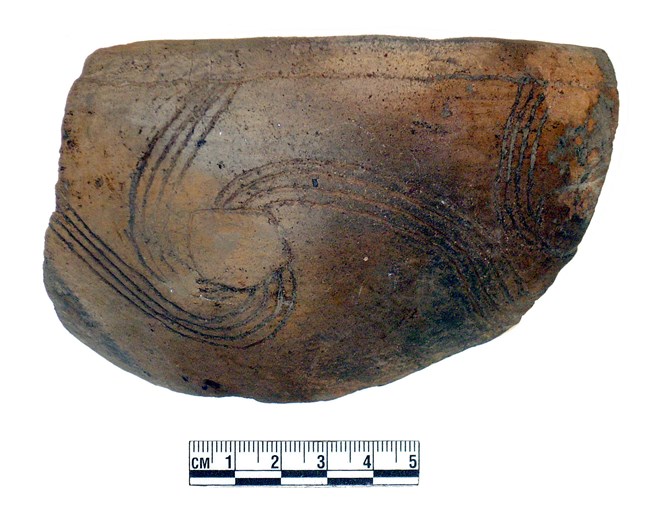
Untold Stories
Archeologists have found evidence of the earliest pottery in North America right here in the Southeast, and it is more than 4,000 years old! Over many years, ancient Native Americans shared the knowledge of making pottery with others, and many styles and shapes were created. Different styles and shapes were made by groups of people who lived in different places; tribes living along the coast made pottery that was different from those living along the Mississippi River or in the mountains. Tribes or villages decorated and painted their pottery with symbols that may have identified their family, where they lived, and their social status or rank (if they were a farmer, a fisherman, a priest, or a leader). Some symbols represented animals, such as crabs, turtles, birds, and others represented nature, such as ocean waves, lightning, and the wind. Archeologists use these designs determine if different groups of Native Americans were interacting with each other through trade, marriage, or even war.
They used all kinds of things to decorate their pottery, including paint, carved paddles, and even fingernails! Sticks, rope, and fabric were pressed into clay while it was still damp.
Symbols also were carved onto large rocks – these are called petroglyphs. Some petroglyphs created near streams or rivers marked a tribe’s territory, just as a fence marks a person’s yard. Others were carved into smaller stones that marked the boundaries of ballcourts or open plazas in the middle of the village where people played games, danced during celebrations, and held important meetings.
American Indian Words We Use Today
Many of the words that we use today were originally Native American. Words such as canóa (canoe), huracán (hurricane), cáyo (island, or key/cay), and barbacóa (barbeque) are now very familiar to us. Some have changed over the years, but the main part of the word is based from a Native American word.
Similarly, many foods that we eat today originally were from the Americas, such as cacao (chocolate), vanilla, chili peppers, sweet potatoes, mahíz or maize (corn), tomatoes, peanuts, avocados, and even pineapple. When Europeans arrived and began to establish ports and towns, they brought their own foods and animals, including cows, goats, chickens, rice, sugar, coffee, oranges, and wheat. Archeologists often find food remains at sites, which can tell them what people ate and whether they traded with other people, bought expensive food in town markets, or hunted for their supper.
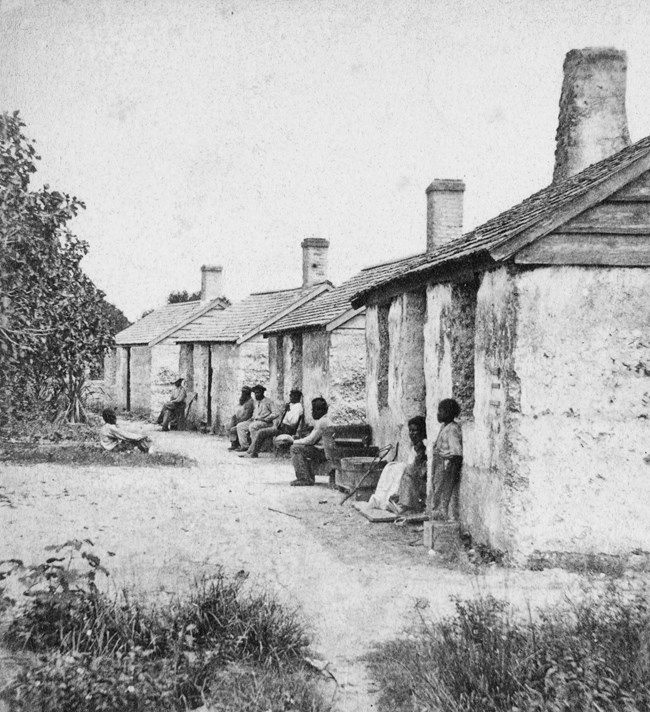
The Life of an Enslaved Person
Slavery has existed around the world for many, many centuries, even in ancient Greece and Rome. In Africa, only wealthy and powerful people owned slaves. The Atlantic slave trade did not begin until Europeans in the New World wanted people to plant their crops and look for gold and silver. From 1650 to 1860, between 10 and 15 million people were enslaved and brought to the Americas from western Africa. The Spanish wanted people to work the gold and silver mines of South and Central America. Spanish, Dutch, French, Danish, English, and Americans wanted slaves to work sugar, rice, cotton, indigo, and tobacco plantations.
Field slaves had a hard life—their day began before sunrise and ended after sunset. Some slaves may have lived in houses made of wattle-and-daub, but many lived in wooden, stone, or brick houses. Slaves had to grow much of their own food, and some hunted and fished.
Not all plantation slaves worked in the fields. Some worked in the house. They cooked, cleaned, sewed, and raised their owner’s children. Others worked as crafting slaves—they were blacksmiths, barrel makers (coopers), bricklayers (masons), and carpenters. Many slaves who lived in towns worked in houses and were trained to work as hairdressers, tailors, carpenters, and even musicians.
Many slaves who ran away used the Underground Railroad to escape. The Railroad was really an unorganized network of people and services that helped the runaways during their journey north to freedom. As maroons, the slaves hid and lived in swamps, mountains, and other places that were difficult to reach. Archeologists investigate the lives of enslaved people, most of whom could not record their feelings or their experiences. Their only voice about who they were, where they came from, and what they believed are the objects they left behind. SEAC archeologists have studied the lives of slaves at many parks in the Southeast, including Cumberland Island National Seashore, Charles Pinckney National Historic Site, Timucuan Ecological and Historic Preserve, and Cane River Creole National Historical Park.
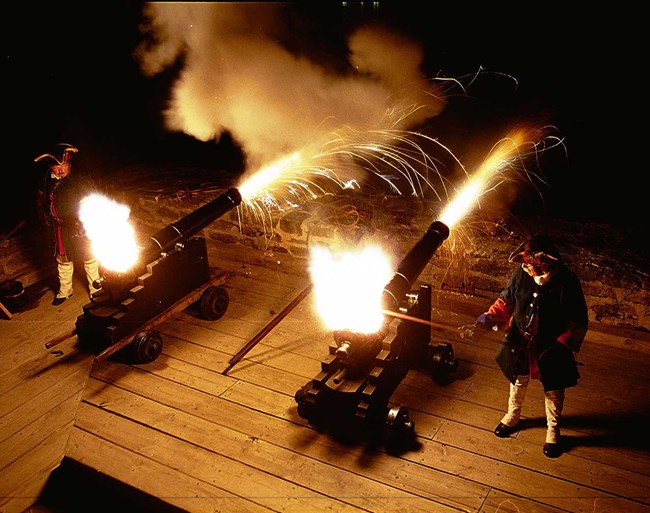
Guns, Swords, and Cannons
Across the Southeast Region, many reminders exist of the struggles to create and preserve the United States. Revolutionary War battlefields, Civil War forts, and military bases all tell the stories of the brave men and women who fought and died to protect our country. From the earliest days of European settlement, guarding the coastlines has been vital for the protection of the interior. Archeologists discover how soldiers moved across a battlefield, where they attacked and retreated, where they camped and cooked their food, and where they tended their wounded at field hospitals. Sometimes archeologists get to rewrite history by discovering what really happened; at the Civil War prison of Andersonville, archeologists discovered how the prisoners built their own shelters, survived freezing winters and hot summers, and how they survived until the war was over!
Forts such as Castillo de San Marcos show us the history of fort design and technology. Many forts in the Southeast are located along the Atlantic and Gulf Coasts, including Fort Massachusetts, Fort Sumter, Fort Moultrie, and Fort Jefferson, where they defended the coastline from possible naval attacks. Away from the coast, one of the largest earthwork forts built during the Civil War is Fortress Rosecrans at Stones River National Battlefield.
Soldiers stationed at a particular place to guard and to live are called a garrison. The buildings in which they live also are called a garrison. At St. Augustine the Spaniards used Native Americans as their work force to build many forts before they created one that would not be destroyed by heat, rain, hurricanes, and invaders! The fort is built of coquina, a stone that is made up of tiny seashells. Today, Castillo de San Marcos is National Park Service site, known as Castillo de San Marcos National Historic Site.
Changes to the design of artillery allowed cannons to fire longer distances. The smooth bore cannon from the 17th and 18th centuries fired a round only 500 yards. During the Civil War (1863), a parrott rifle fired a round 2,000 yards. The Endicott Gun of the Spanish American War (1898) fired more than 8,000 yards, and today’s artillery can fire on a target a whopping 25 miles away!
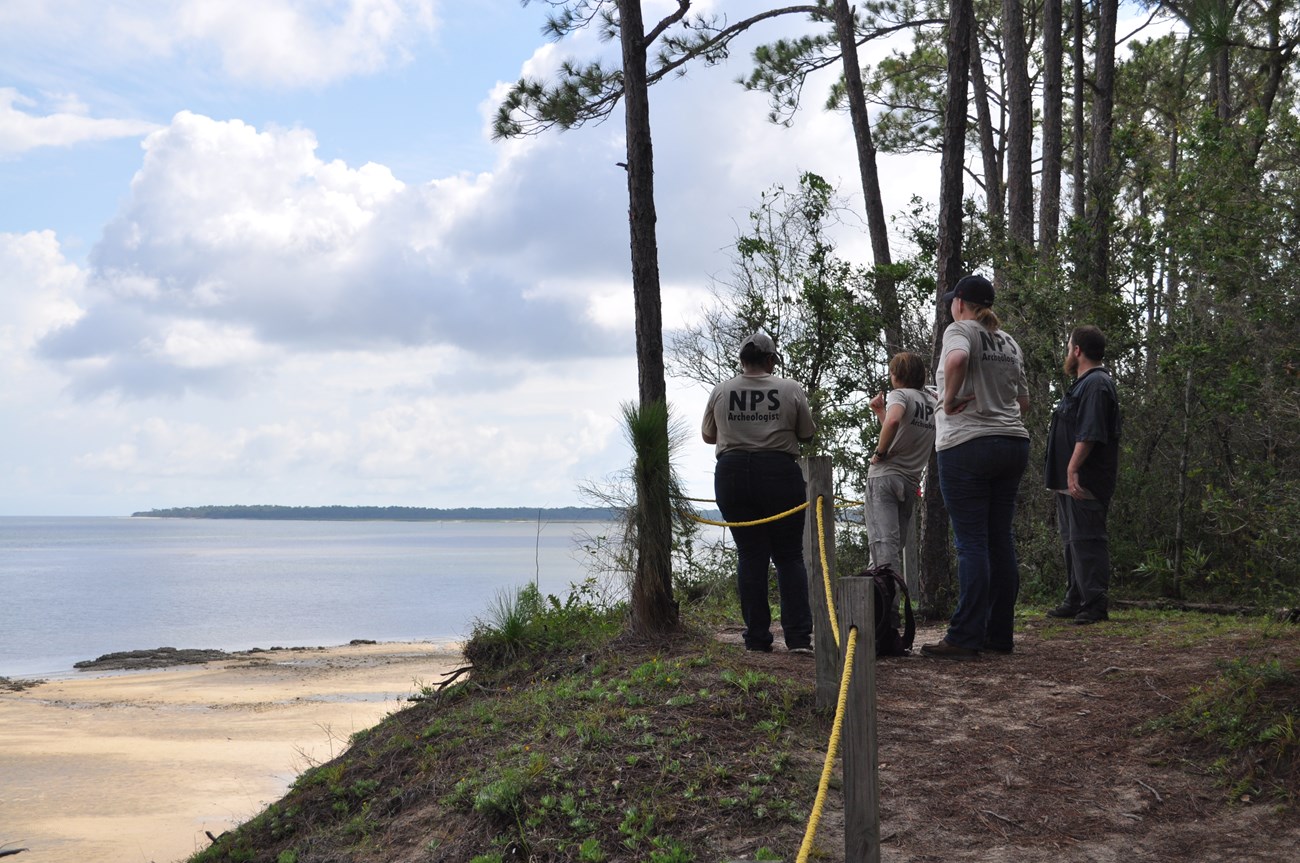
Protect Our National Parks
People have always used items from nature, such as plants, rocks, and animals, for food or to make shelter, clothing, tools, and weapons. Archeologists find the remains of these items when they dig at a site. You can find many of these things today when you visit a national park!
Many people visit National Parks every year – to play, picnic, hike, fish, and camp. Most people who visit the parks are responsible and careful and throw away their trash properly. However, some people are careless and leave their trash on the ground or even throw it off their boats and out of their cars! This trash takes a long time to decompose, or break down or rot, and some trash, such as broken glass and metal, can be dangerous.
Archeologists dig up the trash left behind by people from a long time ago. What kinds of trash do we leave behind and how long will it be there? The list below shows how long it takes for things that you use every day to decompose:
Paper – 2 to 5 months
Coated milk carton – 5 years
Painted wood – 13 years
Styrofoam – over 50 years
Batteries – 100 years
Plastic soda bottle – 500 years
Fishing line – over 500 years
Remember – have respect for the people and places you visit during your National Park Service adventure! Leave behind any artifacts that you find so others may enjoy and learn from them!
Archeology Featured Articles
Last updated: March 11, 2020
